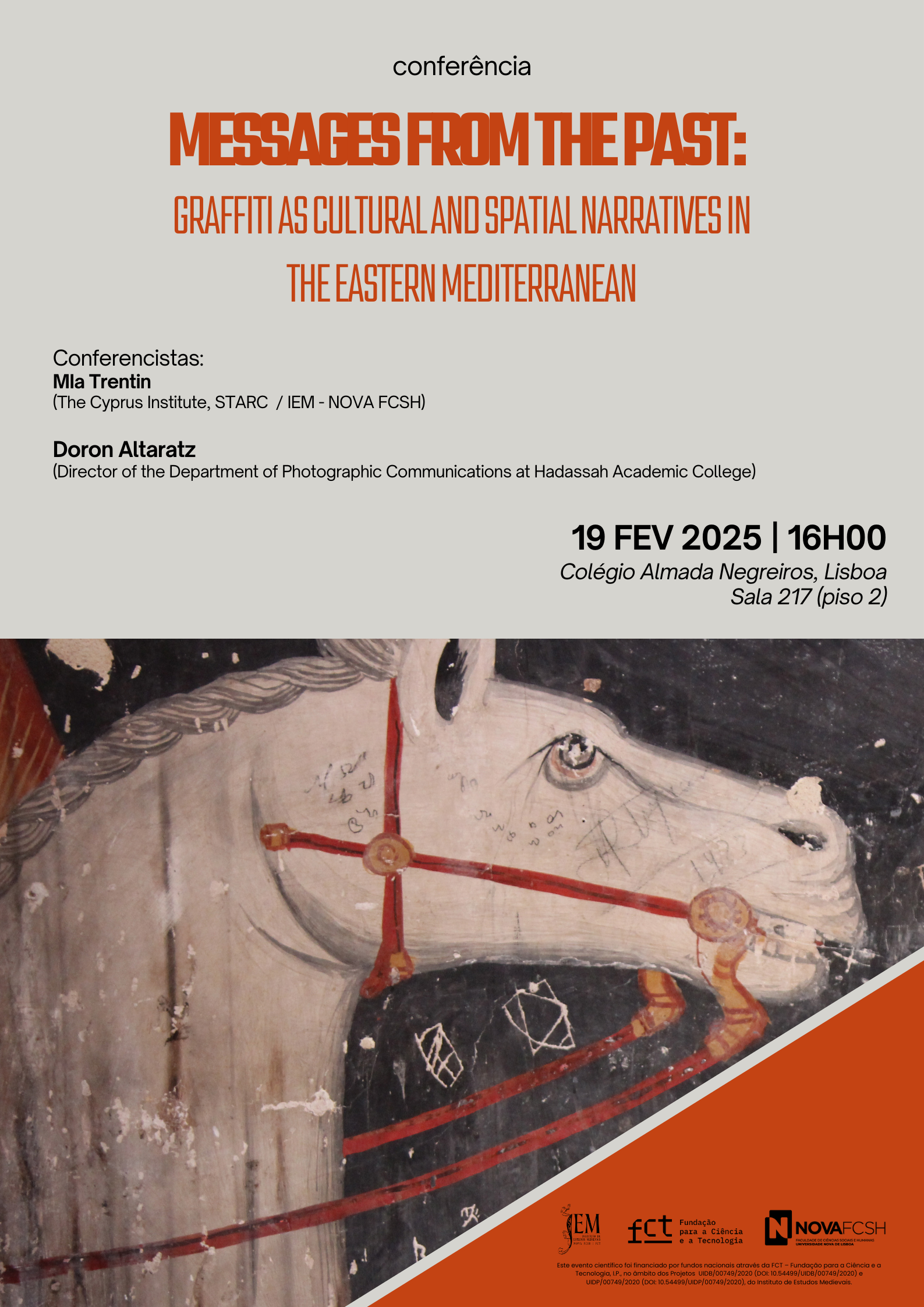Conference “Messages from the Past: graffiti as cultural and spatial narratives in the Eastern Mediterranean”
Colégio Almada Negreiros, room 217 (2nd floor), Lisbon
19.02.2025 | 16:00 - 18:30

Organized by the IEM Research Group, Images, Texts and Representations (ITR), the conference “Messages from the Past: graffiti as cultural and spatial narratives in the Eastern Mediterranean” will take place on February 19th, between 4 pm and 6:30 pm, at Colégio Almada Negreiros, room 217 (2nd floor), Lisbon.
The conference will feature contributions from Mia Trentin (The Cyprus Institute, STARC / IEM – NOVA FCSH) and Doron Altaratz (Director of the Department of Photographic Communications at Hadassah Academic College, Jerusalem).
Mia Trentin
Ephemeral traces, enduring stories: deciphering Cypriot Medieval and Early Modern graffiti
Abstract
Cyprus’s historical buildings are more than mere architectural remnants of the island’s multicultural past; they encapsulate its diverse and vibrant history while preserving past communities’ intangible narratives and emotions.
Graffiti inscribed on these structures offer a unique glimpse into the past, recounting events, prayers, and hopes of those who journeyed to the island long ago. Through extensive study and analysis, the rich corpus of medieval and modern Cypriot graffiti has emerged as a valuable resource, illuminating the intimate dimensions of multicultural Cypriot society.
This presentation explores how historic graffiti not only enhances our understanding of past communities but also establishes a tangible link between the present and the past, connecting us with ancient practices and traditions that continue to resonate today.
Biographical note
Mia Trentin is an archaeologist and historian working in digital humanities. She is a fellow of the Society of Antiquaries of London (FSA).
She has an interdisciplinary curriculum, including Archaeology (BA), Cultural Heritage Studies (MA), and Social History (PhD), with a thesis on Medieval Graffiti along the Northern Italian pilgrimage routes.
From 2017 until the beginning of 2024, she worked at The Cyprus Institute—STARC—APACLabs, collaborating with local and international institutions on heritage documentation. Her specific focus was on digital tools and technologies for studying Cypriot graffiti heritage.
She investigates Medieval and Early Modern written culture in all aspects, from traditional historical study and source editing to epigraphy. Her expertise is in informal written communication – graffiti – focusing on written and visual expression to recover past people’s practices, attitudes, and approaches to their surrounding natural and anthropic space.
She led the GRAFMEDIA project (GRAFfiti Mediterranean DIALogue, 2020-2021) and DIGIGRAF (DIGIizing GRAFfiti, 2022-2023), creating the first open-access repository for the study of Medieval and Early modern graffiti. She is also engaged in EU project consortia, aiming to promote Cypriot graffiti within the academic community, education, and valorisation through community involvement and citizen science.
Doron Altaratz
From walls to data: photographic and computational approaches to graffiti research
Abstract
Graffiti are an original source to explore the visual culture and expression of past societies. Nevertheless, their ephemeral nature and lack of general awareness threaten their preservation, putting them into heritage at risk. The first necessary step to guarantee their preservation and foster their study is efficient and ad hoc documentation.
The lecture will present the main challenges and the most up-to-date solutions to provide efficient and high-quality documentation of graffiti heritage in all its aspects, combining traditional photographic techniques with cutting-edge computational tools. This integrative approach uncovers the enduring relevance of graffiti as a medium for personal expression and collective memory across time.
The lecture offers a transformative perspective on historic graffiti research by bridging traditional and technological methodologies. It underscores the potential of interdisciplinary approaches to illuminate the voices of the past, making it an invaluable resource for historians, archaeologists, and digital humanities scholars.
Biographical note
Dr Doron Altaratz is the director of the Photographic Communications Department at Hadassah Academic College in Jerusalem. As an academic researcher and multidisciplinary artist with extensive experience in the creative industries, he bridges the intersection of technology, art, and critical media studies. His research focuses on computational imaging’s role in cultural heritage preservation, media critique, and the automation of computational photography processes.
In his artistic practice, Dr Altaratz delves into computational photography, interactive installations, physical computing, and mixed reality, exploring computational systems’ profound cultural and social implications on image creation and perception. His work seamlessly integrates critical thinking and innovative creative practices, fostering a dynamic dialogue between technology and the arts.
Dr. Altaratz earned an M.P.S. in Interactive Media from New York University and a Ph.D. in Media and Communications from the Hebrew University of Jerusalem. A prolific academic contributor, his publications span topics such as computational photography, its impact on professional identity, and the application of advanced imaging technologies in documenting and preserving cultural heritage.
